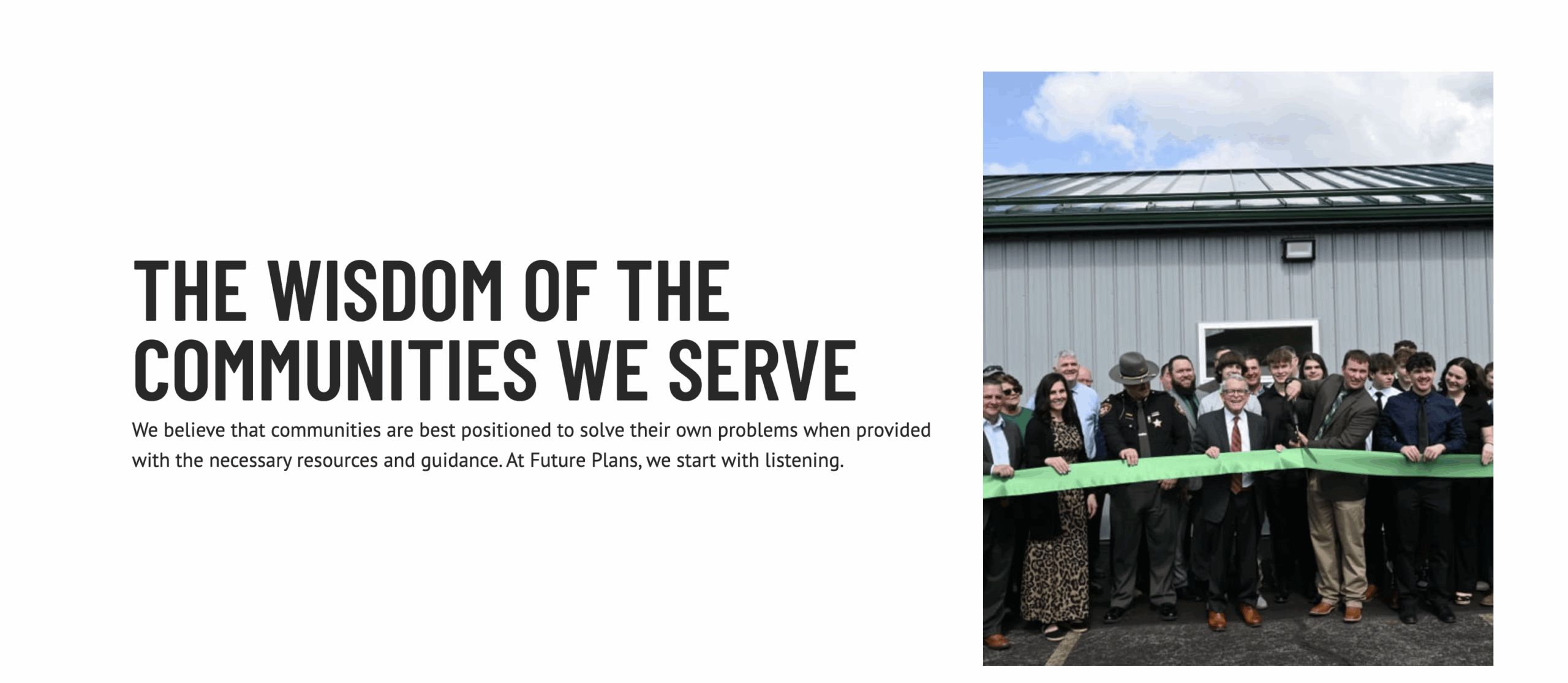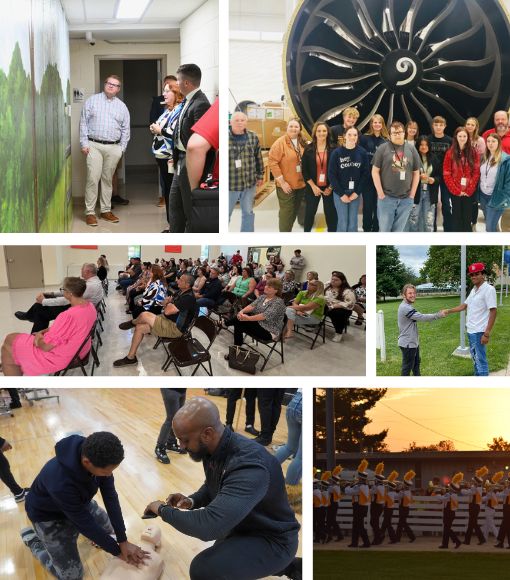
Future Plans is Supporting the Development of the Rural AI Workforce
“Too often, people who are poor are told what they should do,” says Dr. Denise Reading, President and CEO of Future Plans. ”At Future Plans we ask ‘What do you want to do? What do you think would work?’ We believe they know best, and it is our job to listen and then to provide consistent support. By doing this, we have seen amazing individual and community transformations. At the end of the day, our goal is to eradicate poverty by supporting the action of those who are most impacted.”
Founded in March 2022, Future Plans, Inc. is an Ohio nonprofit with a history of success in building grassroots coalitions. Their mission is to help people at any stage of their lives build a better tomorrow. Future Plans has supported over 26,000 rural Ohioans in developing and executing their individual career plan that results in living wage jobs through their GRIT program , and are about to launch an AI literacy and AI workforce program to uplift some of Ohio’s poorest communities.
Along with Dr. Chris Unger and the All4AI team I participated in a two-day tour of several Future Plans programs. The group visited multiple sites across various counties, including in Latham, Ohio; Western Local School District/West L.A., Dragonfly Village – Brown County, Adams County Workforce Development Center, Shawnee State University Kricker Center for Innovation, New Lexington High School – Perry County, Vitruvian 3-D Printing – Athens County, Glouster G.R.O.W. – Athens County, Hocking Hills Chamber of Commerce & Co-Working Space, Hocking County Hocking Hills Garment Industry, and Buchtel Village, Athens/Hocking Counties. Future Plans now operates in 32 Appalachian Ohio counties through the GRIT project and, as of 2024, has expanded to three communities in Cleveland: Cleveland Heights, Shaker Heights, and East Cleveland.
Quantitative Outcomes
Future Plans has achieved substantial measurable impact across multiple metrics:
- Scale of Service: Over 16,000 individuals have been assessed, coached, and provided with career plans over five years.
- Educational Institution Engagement: 87% of participating high schools have implemented or expanded their career education programs.
- High-Risk Population Success: 68% of high-risk seniors without post-graduation plans and with an average ACE Score of 5+ have completed credentials and proceeded to post-secondary education or employment.
- Adult Employment Outcomes: 14% higher adult job placement rate for underemployed/never employed individuals compared to the rest of Ohio.
- Displaced Worker Success: 25% higher displaced worker placement rate compared to Ohio averages.
- Geographic Expansion: Rapid growth from one county to all 32 Appalachian Ohio counties, plus expansion into urban Cleveland
Economic Impact Evidence
Dr. Denise Reading’s testimony before the Ohio Senate Health Committee highlighted the program’s significant return on investment, with the GRIT Project generating approximately $350 million in economic impact from $38 million in funding. This represents a 9:1 return ratio, demonstrating substantial economic value creation for the state of Ohio.
The GRIT Project was ignited by four community members in Adams County, Ohio, who wanted a better future for the young people of their community. Plagued by the existence of their largest employer, long-term unemployment, and the impact of the opioid epidemic, people had lost hope. Those four people became 12, and 12 became 70, and the people identified that purposeful work was the most important way they could rebuild hope. They also identified barriers to work. They realized that if they did not take action to overcome those barriers, no one else was going to do it. A better future for Adams County was their responsibility. Today, GRIT is going strong in all 32 counties of Appalachia, putting people to work, breaking the chains of generational and situational poverty, overcoming the barriers of childcare, transportation, recovery, re-entry, access, and opportunity. A critical barrier for the people of Appalachia and rural communities is access to technology. We saw this firsthand when people sat in parking lots next to school bus hot spots during the Pandemic. With each new tech innovation, the people of Appalachia fall further behind but if they can access and utilize AI they can make great leaps forward.
Listen to Pike Western Local Schools Superintendent Brock Brewster relate two uplifting stories about a student and a former student, whose lives were transformed through their participation in the GRIT Project, through Future Plans:
Gavin Reed’s story shows how perseverance, self-advocacy, and effective support can influence one’s future. As a participant in the Defiance Dream Center’s Workforce Development Program, Gavin gained hands-on experience in automotive and construction training while also earning his OSHA 10 certification. But his path did not stop there—he was determined to build a career that aligned with his skills and aspirations.
After completing his high school credits, Gavin took the Future Plans assessment, which helped him uncover his strengths, interests, and career goals. Armed with this knowledge and guided by coaching workforce, he prepared for an interview at a local meat manufacturing company. However, instead of simply accepting the first offer, Gavin made a bold move—he used his self-advocacy skills to negotiate with his current employer, Spyker Contracting, securing a role with benefits that made it the perfect fit.
Lilyann Aufdencamp is taking her future into her own hands by dedicating her Gap Year to meaningful, hands-on work in home weatherization. Through MoveUp Ohio (a Future Plans Program), in partnership with Gap Quest, Lily is working as a Crew Technician in the Home Weatherization division of NeighborWorks Toledo Region (NWT). Her role involves helping low-income residents improve the energy efficiency and sustainability of their homes—an impactful initiative that benefits both families and the environment.
Her commitment and hard work have earned her national recognition, and she was recently awarded a $1,500 Gap Year Sustainability Scholarship to support her journey. As a recent graduate from Fostoria High School, Lily is not only gaining real-world experience but also exploring skilled trades as a potential long-term career.
Working 32 hours per week, Lily is developing essential skills in construction, energy efficiency, and home improvement—all while making a tangible difference in her community. Her dedication to learning and service is a true testament to the power of hands-on education.
Lily’s advice?
“Work hard, play hard, and don’t be afraid to get dirty!” I am finding myself more and more everyday thanks to Gap Quest & NeighborWorks – thank you!”
AI for Appalachia
Dr. Denise Reading “Rural communities often have limited access to teachers who are trained to teach tech related courses. As a result, the communities fall further behind in competitiveness for participation in the Global economy. At least that was true until the introduction of AI. Many across Appalachia are beginning to see that AI can help them close many of the gaps that exist. AI can close instruction gaps, support small businesses in being more successful, and create new economic opportunities. But this can only happen if every citizen knows how to use AI in a productive way and if those who are wired for it learn how to work in the AI industry. At Future Plans we believe AI will make a more significant difference than the telephone and television in connecting Appalachia to the world. AI will not just connect the people of Appalachia to information; AI will help to close the capacity gap. AI will level the playing field. That is why we are committed to the idea of ALL4AI.”
Christa Krohn, Executive Vice President of Social Enterprise and Strategy: “Without broadband access, devices, and training, rural communities’ risk being left further behind as AI reshapes the workforce. With the right investments, however, AI can democratize opportunity: personalized education, open access to remote workforce training, revitalize industries, innovate existing industries, advance agriculture, and support new small business tools and entrepreneurs. In rural communities, trust is built over time and through relationships. AI adoption must reflect that—investing not only in needed infrastructure to support the tech but in people, training, and local leadership is what makes the technology truly work. Technology and people must go hand in hand. Investing in AI tools without investing in human capacity and trust leaves communities behind; real progress happens when both advance together.”
Mary Ellen Dobranski, Executive Vice President of Programs and Regional Impact: “Growing up in rural Appalachia, my connection to our hills and towns is deeply personal. My family’s story is woven into the fabric of this region, and my experiences have shaped my understanding of the challenges and strengths within our communities. As Vice President of Programming and Regional Impact at Future Plans, these local roots guide my commitment to helping families build brighter futures.”
The organization’s continued growth demonstrated impact metrics, and recognition from state officials indicate strong potential for long-term sustainability and expanded influence in workforce development. By thoughtfully integrating emerging technologies while maintaining their community-focused approach, Future Plans is well-positioned to serve as a model for effective workforce development in both rural and urban contexts.
Future Plans exemplifies how grassroots organizations can achieve significant economic impact through strategic partnership building, data-driven programming, and unwavering focus on individual empowerment within community contexts. Their success provides valuable insights for other communities seeking to address workforce development challenges while building sustainable economic growth.

Source link


